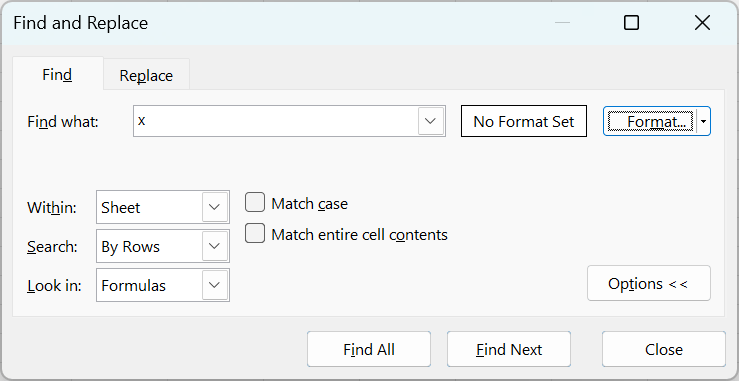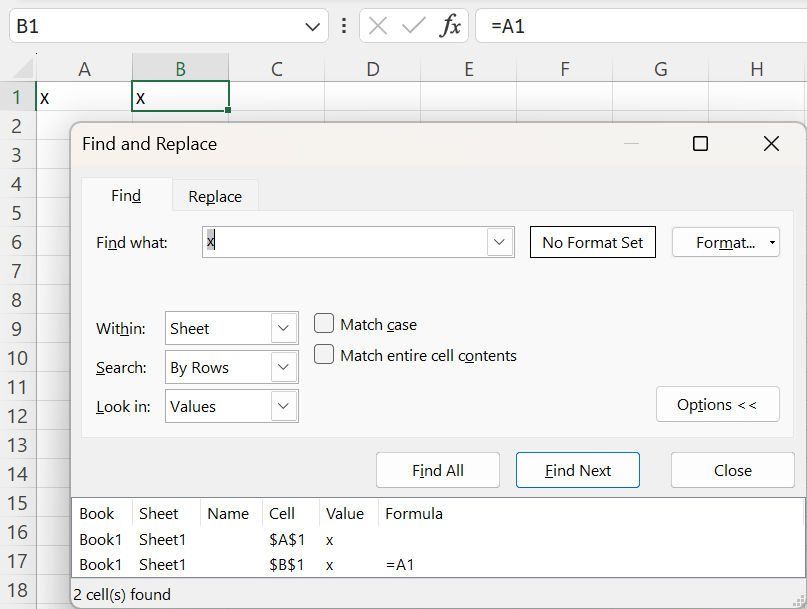VBA code to find cells in a range
The Find method of the Range class is used to find
cells containing a given value or format in a range.
Find in worksheet
In its basic form Find is called like the code below, which selects the found cell. The code will only work if the value actually is present on the worksheet.
ActiveSheet.UsedRange.Find(What:="x").SelectActiveSheet method to provide the parent Worksheet object whose Range class is being used. In real code using explicitly declared and assigned object variables is preferred,
in the current case: Dim wsActiveSheet As Worksheet: Set wsActiveSheet = ActiveSheet , quite likely with another object assignment expression.
The Range class object here is obtained from the Worksheet UsedRange procedure.
The procedure returns an object of type Range which is optionally assigned to a variable rngFound.
Generally, you will use a variable, here: strWhat to assign the What parameter.
Dim strWhat As String: strWhat =
Dim rngFound As Range
Set rngFound = ActiveSheet.UsedRange.Find(What:=strWhat)The Find method returns Nothing if no match is found.
Find in range
Search for value in column
Below code lets you find a cell containing the value in a given column.
Dim rngColumn As Range
Set rngColumn = ActiveSheet.Columns(3)
Dim rngFound As Range
Set rngFound = rngColumn.Find(What:="x").SelectSearch row for value
Use the following code to find a cell containing the value in a row.
Dim rngRow As Range
Set rngRow = ActiveSheet.Rows(8)
Dim rngFound As Range
Set rngFound = rngRow.Find(What:="x")What: specify search criteria

Find what
The data to search for. Can be a string or any Microsoft Excel data type. Some advice on suitable parameter values:
- When searching numeric values use
Lookin:=xlFormulasandLookAt:=xlWhole - When searching date values use
Lookin:=xlFormulasandLookAt:=xlWhole. The supplied date should be like25/02/2024which you can get usingFormatDateTime(dtDate, vbGeneralDate)
- When searching numeric values,
LookAt:=xlPartmay cause you to find more numbers than you want: if you search for 1 you will also get 301, 12 and do on. - If columns are smaller cells may not display the value, but ### instead. You may be safer by combining with
Lookin:=xlFormulas
After: start cell for search
If After has been specified, the search begins after this cell;
the specified cell isn't searched until the method wraps back around to this cell.
After argument must be a single cell in the range.
If not, you get .
Below code starts search after the active cell mimicking the Find Dialog
Dim rngFound As Range
Set rngFound = ws.UsedRange.Find(What:="x", After:=ActiveCell)LookIn: Formulas, Values, Notes, Comments
Can be one of the following XlFindLookIn constants: xlFormulas (Formulas), xlValues (Values), xlComments (Notes), or xlCommentsThreaded (Comments).
Dim rngFound As Range
Set rngFound = ActiveSheet.UsedRange.Find(What:="x", LookIn:=xlComments)xlFormulas vs xlValues
The difference between Find Formulas or Values could be observed experimentally. Put in A1 value x and in B1 formula =A1. In the Find Dialog press Find All. With Formulas selected only A1 is found while with Values both A1 and B1 are found.
- Formulas looks at what the cell contains as what is available in the Formula bar ;
- Values matches on what is displayed as value in the grid cell.

LookIn, LookAt and SearchOrder explicitly each time you use the Find method.
LookAt: Match entire cell contents
Can be one of the following XlLookAt constants: xlWhole or xlPart. Use xlWhole if you need to find cell with specific text.
Add MatchCase:=True if you are required to find an exact match in the range (case-sensitive).
Dim rngFound As Range
Set rngFound = ActiveSheet.UsedRange.Find(What:="x", LookAt:=xlWhole, MatchCase:=True)Using wildcards
In Excel you have a limited use of wildcard characters in the Find argument:
- a question mark (?) matches one character if within a string;
- putting a question mark at the begin or end matches also if there are more than 1 characters.
- An asterisk (*) matches any series of characters.
As an example, below code finds any cell that matches 'x'.
Set rngFound = ActiveSheet.UsedRange.Find(What:="?x*")The TestFindAll procedure (bottom of the page) helps you determine what results may be expected with given find arguments.
It writes the Address of the range to the Immediate window: $B$1:$C$1,$C$2

SearchOrder: Rows or Columns
Can be one of the following XlSearchOrder constants: xlByRows or xlByColumns.
- Search by column means search first all cells in column A, then column B etc.
- Search by row means search first all cells in row 1, then row 2 etc.
Dim rngFound As Range
Set rngFound = ActiveSheet.UsedRange.Find(What:="x", SearchOrder:=xlByRows)SearchDirection: Find Next
The search direction together with SearchOrder will determine What will be next cells. Below combination will move up in columns upward, e.g. assuming UsedRange last cell is B6: B6, B5, B4...
Dim rngFound As Range
Set rngFound = ActiveSheet.UsedRange.Find(What:="x", SearchOrder:=xlByColumns, _
SearchDirection:=xlPrevious)Range find multiple criteria
To find cells that match more complicated patterns you can use a For Each...Next statement with:
- the Like operator,
- Apply boolean tests combined using And, Or, etcetera.
For example, the following code searches for all cells in the range A1:C5 that use a font whose name starts with the letters Cour. When Microsoft Excel finds a match, it changes the font to Times New Roman.
Dim rngCells As Range
Set rngCells = ActiveSheet.UsedRange.Cells
Dim rngCell As Range
Dim rngFound As Range
For Each rngCell In rngCells
If rngCell.Font.Name Like "Cour*" Then
Set rngFound = rngCell
Exit For
End If
Next rngCell SearchFormat: Format...
Return cells only with certain formatting applied (font, background color,...).
Below example shows you can find all cells that have a background color by using an empty string for the What parameter.
Uncomment .Color = 65535 to get the cells marked yellow. Alternatively you could filter on cells made Font.Bold
or other properties of the cell.
What and FindFormat finds only cells that match both criteria.
Sub Demo()
With Application.FindFormat
.Clear
' .Font.Bold = True
With .Interior
.Pattern = xlSolid
'.Color = 65535 'rgbYellow
End With
End With
ActiveSheet.UsedRange.Find(After:=ActiveCell, What:="", SearchFormat:=True).Select
Application.FindFormat.Clear
End Sub Clear the FindFormat (both before and) after running the Find.
MatchByte: e.g. Japanese and Chinese
Used only if you have selected or installed double-byte language support. True to have double-byte characters match only double-byte characters. False to have double-byte characters match their single-byte equivalents.
Author: Mark Uildriks Reference: Range.Find(Excel) | Microsoft Learn
